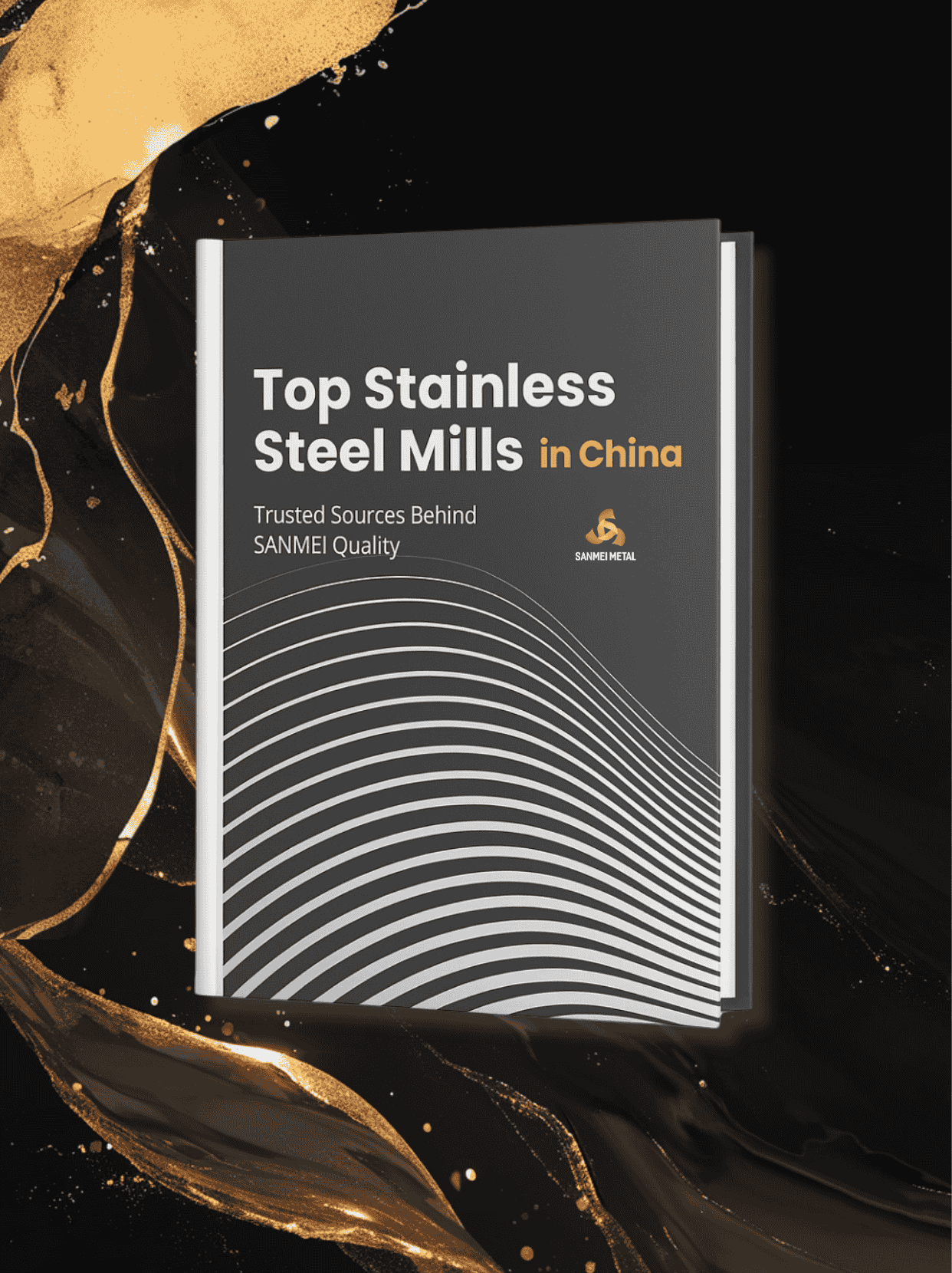
Hol dir deins FREI Zugang: Chinas #1-Stahlwerksdossier
Käuferorientiert: Passende Walzwerke nach Güteklasse/Oberflächenbearbeitung/Breite-Dicke/Anwendung
BAOWUTsingshanLiscoTisco
Details und Beispiele ansehen →


430 entspricht
Korrosionsbeständigkeit von Edelstahl 430
Gute Beständigkeit gegenüber milden atmosphärischen Bedingungen und Süßwasser. Weniger beständig gegen Lochfraß und Spaltkorrosion als 304.
Hitzebeständigkeit von 430 Edelstahl
Oxidationsbeständig bis 870°C.
Bearbeitbarkeit von Edelstahl 430
Edelstahl 430 lässt sich ähnlich gut bearbeiten wie Weichstahl. Der Einsatz von Spanbrechern und die richtige Schmierung verbessern die Leistung.
Schweißen von 430 Edelstahl
Wenn Schweißen erforderlich ist, empfiehlt es sich, Edelstahl 430 durch stabilere Sorten wie Edelstahl 439 oder 441 zu ersetzen, um Schweißrisse zu vermeiden und Risiken sowie Produktionskosten zu senken.
Warmbearbeitung von Edelstahl 430
Die Warmbearbeitung sollte bei 816 – 1038 °C (1500 – 1900 °F) erfolgen. Um die maximale Korrosionsbeständigkeit zu erhalten, wird ein Glühen nach der Bearbeitung empfohlen.
Glühen von 430 Edelstahl
Das Glühen erfolgt bei 1450 – 1650 °F (788 – 899 °C), gefolgt von langsamem Abkühlen, um Sprödigkeit zu vermeiden.
Härten von 430 Edelstahl
Edelstahl 430 kann nicht durch Wärmebehandlung gehärtet werden. Durch Kaltverformung kann er leicht gehärtet werden.
Kaltbearbeitung von Edelstahl 430
430 kann kaltbearbeitet werden, kann aber aufgrund seiner ferritischen Struktur leicht magnetisch werden.
| Physikalische Eigenschaften von Edelstahl 430 | |
| Eigentum | Wert |
| Dichte | 0,278 lb/in³ |
| Elastizitätsmodul | 29,0 x 10^6 psi |
| Wärmeausdehnungskoeffizient (68-212°F) | 5,9 x 10^-6 /°F |
| Wärmeleitfähigkeit | 16,2 Btu/Fuß·h·°F |
| Spezifische Wärme | 0,11 Btu/Pfund·°F |
| Elektrischer Widerstand | 24,4 Mikroohm-in |
| Mechanische Eigenschaften für Edelstahl 430 | ||||
| Eigentum | Streckgrenze, min. (ksi) | Zugfestigkeit, min. (ksi) | Dehnung, min. (%) | Härte, max. (Rb) |
| Wert | 35 | 65 | 22 | 88 |
| Grad | Cr (Max) | Fe (Max) | C (Max) | Mn (Maximal) | P (Maximal) | S (Maximal) | Si (Max) |
| 430 | 16-18 | Gleichgewicht | 0-0.08 | 0-1.00 | 0-0.04 | 0-0.02 | 0-1.00 |

Gute Korrosionsbeständigkeit in leicht korrosiven Umgebungen, wodurch sich Edelstahl 430 für Küchenutensilien und -geräte eignet.

430 ist im Vergleich zu höherwertigen rostfreien Stählen günstiger und bietet gute Leistung zu geringeren Kosten.

Im Gegensatz zu austenitischem Edelstahl ist 430 ferritisch und daher magnetisch.

Gute Formbarkeit und Duktilität, wodurch 430 leicht zu formen und zu verarbeiten ist.
Edelstahl 430 kann unter rauen Umweltbedingungen wie hoher Luftfeuchtigkeit oder salzhaltiger Luft rosten. In weniger aggressiven Umgebungen bietet er jedoch im Allgemeinen eine gute Rost- und Korrosionsbeständigkeit. Regelmäßige Reinigung und Pflege können Rostbildung vorbeugen.
Edelstahl 430 ist ein gängiger austenitischer Edelstahl mit den Hauptbestandteilen Chrom (16–18%) und Nickel (0,1–0,5%). Der Stahl 430 weist jedoch einen relativ hohen Kohlenstoffgehalt auf und es fehlen stabilisierende Elemente, was zu einer schlechteren Schweißbarkeit im Vergleich zu stabileren Stahlsorten führt.
Herausforderungen hinsichtlich der Schweißbarkeit: Aufgrund des hohen Kohlenstoffgehalts und des Mangels an stabilisierenden Elementen neigt Edelstahl 430 beim Schweißen zur Bildung von Heiß- und Kaltrissen. Dies erschwert den Schweißprozess und erfordert eine sorgfältige Kontrolle der Schweißparameter.
Verschlechterung der Eigenschaften: Nach dem Schweißen nehmen die Korrosionsbeständigkeit und Duktilität von Edelstahl 430 teilweise ab. Um diese Eigenschaften wiederherzustellen, ist eine Wärmebehandlung nach dem Schweißen erforderlich.
Oxidation nach dem Schweißen: Ähnlich wie andere rostfreie Stähle neigt 430 dazu, nach dem Schweißen eine Oxidationsschicht auf der Schweißnaht zu bilden, die das Aussehen beeinträchtigt. Anschließend ist eine Säurebeizung oder Polierbehandlung erforderlich.
Empfohlene Alternativen: Für Schweißanwendungen mit rostfreiem Stahl sollten stabilere Güten wie 439 und 441 in Betracht gezogen werden, da diese eine bessere Schweißbarkeit aufweisen und ihre Eigenschaften nach dem Schweißen besser beibehalten, ohne dass eine umfangreiche Wärmebehandlung nach dem Schweißen erforderlich ist.
Zusammenfassend lässt sich sagen, dass Edelstahl 430 zwar allgemein gut schweißbar ist, sein höherer Kohlenstoffgehalt und das Fehlen stabilisierender Elemente jedoch zu einer schlechteren Schweißleistung im Vergleich zu anderen Güten führen. Eine Wärmebehandlung nach dem Schweißen ist erforderlich. Für kritische Schweißanwendungen sollten besser schweißbare Güten in Betracht gezogen werden.
410 Edelstahl:
430 Edelstahl:
Zusammenfassung:
410er Edelstahl eignet sich besser für Anwendungen, die eine höhere Festigkeit und Härte erfordern, wie etwa Besteck und Werkzeuge, während 430er Edelstahl für Anwendungen bevorzugt wird, die eine bessere Korrosionsbeständigkeit und Formbarkeit erfordern, wie etwa Küchengeräte und Autoverkleidungen.
Ja, Edelstahl 430 gilt als lebensmittelechter Edelstahl.
Die Hauptgründe, warum Edelstahl 430 für lebensmittelbezogene Anwendungen geeignet ist, sind:
Korrosionsbeständigkeit:
Edelstahl 430 enthält 16-18% Chrom, das eine gute Korrosionsbeständigkeit gegenüber üblichen Lebensmittelsäuren und Chemikalien bietet.
Dadurch ist 430 für den Einsatz in Lebensmittelverarbeitungsanlagen, Küchengeräten und anderen Anwendungen mit Lebensmittelkontakt geeignet.
Sanitäres Design:
Edelstahl 430 hat eine glatte, porenfreie Oberfläche, die leicht zu reinigen und zu desinfizieren ist.
Dadurch wird die Ansammlung von Speiseresten und Bakterienwachstum verhindert und die Hygieneanforderungen für lebensmittelechte Materialien werden erfüllt.
Mechanische Eigenschaften:
Edelstahl 430 verfügt über eine gute mechanische Festigkeit, Härte und Haltbarkeit, sodass er den Belastungen in der Lebensmittelverarbeitung standhält.
Temperaturbeständigkeit:
Edelstahl 430 hält einem breiten Temperaturbereich stand, von Gefrierpunkt bis zu großer Hitze, und eignet sich daher für verschiedene Anwendungen im Lebensmittelbereich.
Während 430 ein gängiger lebensmittelechter Edelstahl ist, werden in der Lebensmittelindustrie auch andere Güten wie 304 und 316 häufig verwendet, da sie eine höhere Korrosionsbeständigkeit und Eignung für bestimmte Anwendungen aufweisen.
Erkenntnisse:

| Typ | Breite (mm) | Gewicht (MT) | Dicke (mm) | ||||
| 430 Spule | 1000, 1219, 1240, 1500 oder kundenspezifisch | 3-10 | 0.15-3.0 | ||||

| Typ | Breite (mm) | Länge (mm) | Dicke (mm) | |||||||||
| 430 Blatt | 1000, 1219, 1240, 1500 oder kundenspezifisch | 2000, 2438, 2500, 3000, 3048 | 0.3-3.0 | |||||||||
Wir verpflichten uns, unseren Kunden den besten und qualitativ hochwertigsten Service zu bieten, um ihre Zufriedenheit sicherzustellen.









Von renommierten Institutionen zertifiziert und der Einhaltung internationaler Standards in jeder Hinsicht verpflichtet.




Kundenfeedback ist der authentischste Ausdruck der Qualität eines Unternehmens.
Edelstahl ist in zahlreichen Branchen ein unverzichtbares Material – von der Lebensmittelverarbeitung und medizinischen Geräten bis hin zu Haushaltswaren, dem Bauwesen und industriellen Anwendungen.
Lebensmittelechter Edelstahl
Edelstahl für den Haushalt
Medizinischer Edelstahl
Sanitärer Edelstahl
Konstruktion Edelstahl
Industrieller Edelstahl
Hauptsitz:
Creating Center, Nr. 142, Yuhe Road, Lecong Town, Shunde District, Foshan City, Guangdong Province, China. 528315
Fabrik: Logistikstadt Liyuan, Stadt Chencun, Bezirk Shunde, Stadt Foshan, Provinz Guangdong, China. 528313
Lokale Support-Basis in Australien: (Yatala, QLD) – Eröffnung 2026